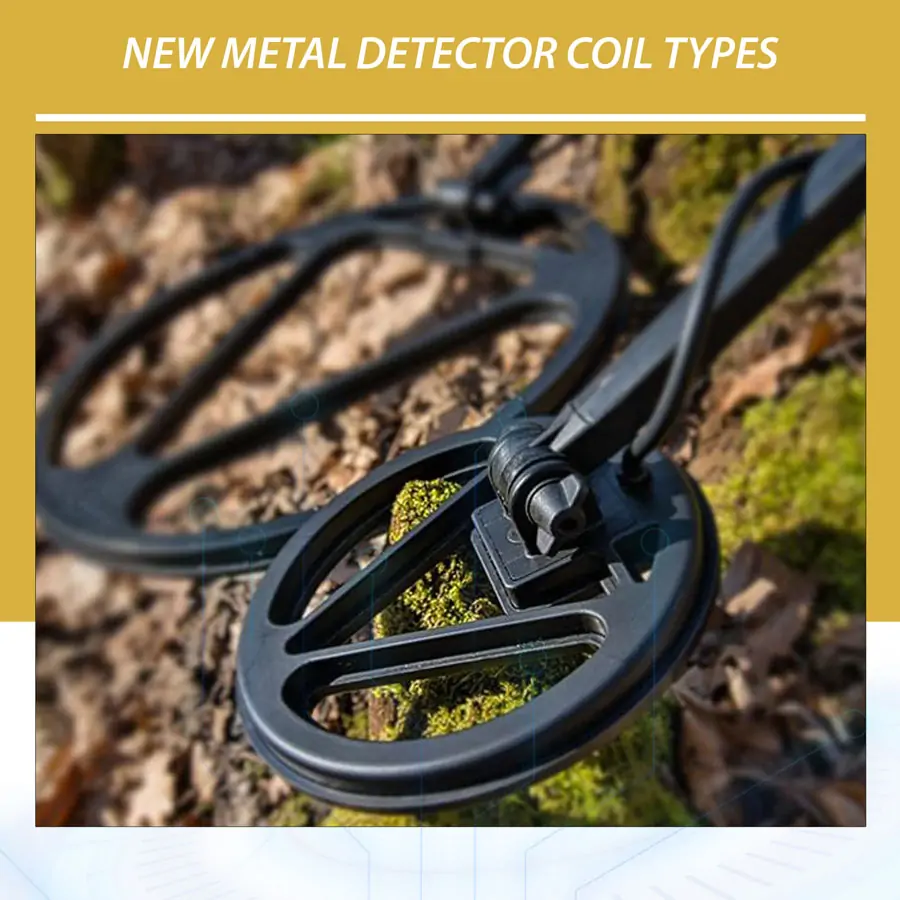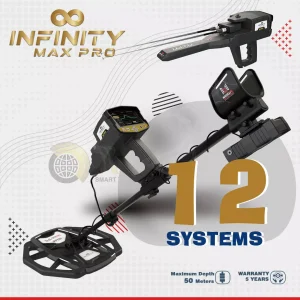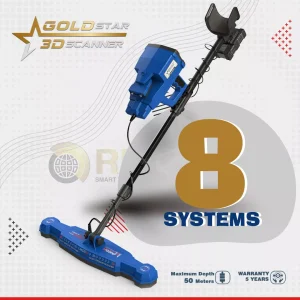New Metal Detectors Coil Type
Whether you are a beginner or an experienced metal detectorist, this article will provide you with the knowledge and clarity you need to make a more informed decision about your search coil to help you get the most out of your metal-detecting equipment.
Before we get started I would like to mention that there are many niche types of search coils we will not be covered in this article. Those will be covered in a future piece, for now, we will be sticking with the models and details that most detectorists should know and will interact with.
What is a search coil?
In short, a search coil is the component of a metal detector that transmits the magnetic field generated by the detector into the ground. It also detects the signals created by interactions with the magnetic field and communicates those signals back to the control box for processing.
How does a Search Coil Work?
Search coils are mounted to the end of a metal detector’s shaft and are passed over the ground in order to search for targets. When the search coil is passed over a metal object, the magnetic field interacts with the objects and creates eddy currents. These currents are then detected by the sensitive search coil and communicated back to the metal detector’s processor. The metal detector’s electronics are then able to interpret this current and display a corresponding ID, creating an audio tone, and on some devices displaying a depth.
Key search coil traits
To better understand the strengths and weaknesses of search coils you will need to learn three key traits that impact their performance. While one changes the shape of the search field,
- Shape (can also be referred to as “type”): The shape of a search coil is one of the most notable differences users will notice and it’s also one of the most consequential. It can impact its coverage area, sensitivity, and maneuverability. The most important thing to understand is: When the search coil shape changes, the shape of the magnetic field being transmitted changes as well.
- Size: The size of a search coil can affect its sensitivity to small targets, as well as its depth and coverage capabilities. Larger coils may be more sensitive to deeper targets but may be less sensitive to smaller or shallower targets.
- Frequency: Some metal detector search coils operate at different frequencies, which can impact their sensitivity to different types of metal and performance in different soil mineralizations. Higher frequencies may be more sensitive to smaller or shallower targets, while lower frequencies may be more effective at detecting deeper targets. Some metal detector coils support various ranges of frequencies to efficiently operate on multi-frequency devices like the Deus/Deus 2.
Let’s explore each of these traits a little more below to get a better understanding of how each impact the performance of your metal detector.
Shapes of Metal detector Coils (Types of Search Coils)
There are several different types of metal detector coils available, each with its own unique features and characteristics. To keep things simplified for educational purposes, we won’t be discussing all of the variations in this article. There are several specialized search coil types that the average enthusiast will never interact with and I see no need in covering them in this piece.
The most common shapes/types of metal detector coils are:
Monoloop coils
The simplest search coil, these coils are made from a single winding of wire in the shape of the letter O. They are typically used for more specialized searches, such as for very small or shallow targets and in pulse induction systems. Mono coils are generally less sensitive to larger targets but may be more sensitive to smaller targets.
The mono coil emits a magnetic field that takes a shape that’s similar to a cone with the broadest part of the cone matching the shape of the search coil.
Concentric coils
Concentric coils are characterized by a circular shape with an inner and outer winding . These were the successor to the mono coil and improved the overall performance in terms of depth and signal stability.
Concentric coils are generally more sensitive to smaller targets but may have reduced depth and target separation capabilities compared to other types of coils. The magnetic field projects from the coil in the shape of a cone similar to the mono coil, with the widest part matching the shape of the outermost coil. Keep this in mind while swinging the metal detector over finds to better pinpoint your hole location while using these classic coils.
Double-D coils (DD Coils)
These coils are shaped like two letter Ds overlapping on their flat edges. These coils are designed to provide improved depth and target separation capabilities. Double-D coils may be less sensitive to small targets and may be more difficult to maneuver in tight spaces compared to other types of coils.
Double-D Coils have quickly risen in popularity thanks to their target separation improvements and depth improvements. The shape of the coil condenses the magnetic field to emit only between where the D’s overlap. The shape of this magnetic field creates a thin band that forms a rectangular shape with rounded corners. This condensed field provides a wider field and a deeper depth as opposed to the concentric coil’s magnetic field that slopes inward towards the point of the cone.
Elliptical coils
I debated leaving this one off but It seems common enough to provide this distinction here. These coils are almost a subset of the DoubleD coil family. They are shaped like an ellipse or oval and are designed to provide a wider coverage area on each pass. Elliptical coils may be less sensitive to small targets compared to concentric coils but can be useful for covering a large area quickly.
The field of these coils is shaped similarly to the field created by the DD coil, which only projects out between the overlapping area of the two search coil sides.
Search Coil Size
Search coils are grouped into three general size categories; small coils which fall under 6 inches in diameter, medium coils which range from 6 to 11 inches, and large coils which cover anything above 11 inches in diameter.
The size of the search coil directly impacts the depth and sensitivity of the metal detector. As the search coil gets smaller, the depth of the emitted field decreases, and the sensitivity to smaller objects increases. Making a smaller metal detector ideal for specialized tasks like prospecting. Conversely, as the search coil size increases the depth of the magnetic field increases but you lose sensitivity to smaller objects and increase your susceptibility to potential interference.
Small Search Coils
These search coils fall under a 6” diameter. As mentioned above, smaller search coils are ideal for more specialized use cases like prospecting. If you’re searching for something extremely small (think a gold flake in the rocks of a river shore), then your best option is a small-diameter coil.
That’s not the only time you should consider using a smaller coil though. If you’re detecting in terrain that has a lot of obstacles, dense vegetation, a high level of mineralization, or lots of iron trash, a small coil can bring a lot of benefits. Its easier maneuverability, improved sensitivity, and condensed coverage will help offset plenty of the issues the obstacles above create.
Medium Search Coils
Search coils sized 6” – 11” are the most common coils you’ll find in both stock packages and out in the field. Coils in this size range provide a good balance between the depth covered and sensitivity.
If you’re just getting started these are the coils you should be considering with your first detector. While it won’t give you the specialization of the other size options, it will be the best well-rounded option you can find and will likely be the coil you put the most mileage on at the end of the day.
Larger Search Coils
Search coils that are larger than 11” comprise this category, with some putting an upper limit of ~24” to isolate some of the more obscure and excessively large outliers. These coils sacrifice sensitivity to penetrate and find objects as deeply as possible. While you might lose out on some of the shallower, smaller finds, you have the chance to locate deeper items that previous detectorists couldn’t reach.
Generally, if you plan to use a larger coil you will benefit from having a more advanced metal detector. Due to the loss in sensitivity, it’s important that your detector has reliable discrimination capabilities, ground balance, and preferably a higher frequency potential to offset some of the sensitivity loss from the increased size.*
*I do want to note, larger coils for most machines tend to operate at lower frequencies due to their size. More capable machines will help you push those boundaries.
Search Coil Frequency
Like the size of the search coil, the metal detector’s frequency also impacts the device’s sensitivity and depth. Unlike search coil size, frequencies add a more slightly complex element to understand because metals will react differently to each frequency based on their conductivity.
Most metal detectors operate at a single frequency between 1.5 kHz/s to 45 kHz/s. Some of the outlier detectors can reach up to 100 kHz/s but you will probably never utilize those for hunting relics and coins.
It’s important to stress frequencies rely on your specific metal detector’s specifications. Each detector has its own range of compatible frequencies and accompanying search coils to match. The more capable metal detectors will be able to change between frequencies and operate at different ranges or emit multiple frequencies simultaneously to maximize coverage (also referred to as multi-frequency). Be sure to thoroughly review search coil details to ensure it is both compatible with your device and capable of operating at your desired frequency.
The Frequency of your detector will also play a key role in how it performs in various soil mineralizations. This is a more complex subject that requires additional details to better understand, we will cover this connection further in a future post so keep an eye out for that update.
If you’re just getting started, don’t stress about your frequency. Your stock coil will carry you a long way and if you ever feel like upgrading you can revisit this in greater detail to determine what’s best for your device and what would work best for your specific soil mineralization.
Understanding Higher Search Frequencies
Higher frequencies have shorter wavelengths. These short wavelengths cause the field to cover a more condensed area that has a greater sensitivity to smaller objects and less conductive materials.
One drawback to operating at a higher frequency can occur if you are searching in an area with a high soil mineralization level. Its increased sensitivity can interact with the mineralization to cause frequent false signals and inconsistent ID interpretations.
Key Attributes:
- Increased Sensitivity
- Decreased search field depth
- Improved detection of less conductive materials
- Better suited for areas with low soil mineralization
- Capable of detecting smaller objects (Gold flakes)
Understanding Lower Search Frequencies
Lower frequencies produce longer wavelengths that travel farther into the ground, giving your device more search depth but sacrificing sensitivity to small objects and less conductive metals.
This decrease in sensitivity can be used to your benefit to decrease false signals and interference in high soil mineralization areas.
Key Attributes:
- Increased search depth
- Decreased interference from soil mineralization
- Better for highly conductive metal types
- Not the best option for detecting gold
Frequently Asked Questions About Search Coils
Below are a few popular questions I’ve been asked or that I’ve come across on social media. There are a few below that are better answered in the details above but to ensure they are directly stated I’ve included a FAQ section to cover the bases.
Which coil is the best for metal detecting?
The best coil changes based on the environment you’re searching in and the targets you’re searching for. If you’re prospecting a smaller mono-loop coil can help you locate tiny gold flakes, but if you’re searching a field for coins a larger DoubleD coil can help you cover more ground.
What do different metal detector coils do?
As explained in detail above, the frequency, depth, and search field shape can vary between different coils. Experienced detectorists will change out their coils based on soil conditions, the quantity of iron/trash in the search area, and their target size or material.
If you are prospecting for tiny gold flakes, you will need a small, mono-loop coil to pick up the tiny targets. If you are searching for coins or other relics, a medium or large search coil can work well but you might want to choose between a DoubleD or Concentric coil based on coil mineralization or the iron debris in the area.
How to test a metal detector coil?
A basic test for any search coil would be to bury similar coins at various depths to see if your detector can pick them up. By staggering the depths of your coins at 3, 6, 9, and 12 inches you will be able to get a better understanding of how your search coils perform for the soil mineralization in your area.
In the past, I’ve kept the targets at least 2 feet apart and buried 4 dimes, pennies, and quarters in a grid to get a good understanding of what my detector could handle. It was also a good way to practice before heading out on our first hunt since our yard didn’t turn up anything.
A good way to quickly set up reusable target areas would be to purchase 4 cardboard tubes at least 2-3 inches in diameter. Measure and cut the tubes at the selected depths you want to test, and then bury the tubes nearly flush with the top or the ground. With these in place, you can always ensure a standardized depth. I’ve even seen a few examples with caps on the bottom and a cord to easily pull the coin back out to test in various soil environments quickly.
What is a DD coil on a metal detector?
A DD coil gets its name from its classic appearance, which looks like two overlapping letter Ds back-to-back. Some modern versions, like the DD coils for the Deus or ORX, will appear like a circle split in the middle with a wider bar vertically since their cover fills the gap between the separate coil sides.
Are metal detector search coils interchangeable?
Yes but there are some limitations. Each metal detector will have its own set of compatible search coils. Before buying a new coil, double-check its device compatibility to ensure it’s the correct model and frequency for your device.
Do I need a coil cover on my detector?
A coil cover is not required but it is recommended. While most modern coils are fairly durable, you’re using this device in rough environments where it will bang up against rocks and scrape across pieces of debris. If you’re investing a decent amount of money into your setup, the relatively small cost to better protect your investment will help you get a longer lifespan from the device.
Final thoughts on the basics of search coils
There aren’t many controllable in the world of metal detecting. To ensure you’re finding every potential target in a search area, you will need to better understand how the few adjustable factors can impact your metal detector’s performance.
Search coils are easy to swap out and can drastically impact your metal detector’s performance. By finding the correct balance of search depth, sensitivity, and frequency for your soil conditions you can ensure you’re coverage is as high as possible to reduce the need for repeat visits to an area. You can also use this information to better target specific target specifications to prevent wasted time for specialized hunts.
If you’re a beginner, understanding the basics will help better understand how to get the most out of your stock coil, which can carry you a long way.
Important articles :
The best and most accurate gold detectors around the world
Metal Detector for Sale 2023
Is it possible to detect gold without a device?
Best Metal Detector for Gold and Silver 2023
Professional Metal Detector
Cheapest Gold Detector 2023
The most important methods of prospecting for gold
Best Metal Detector 2023
Gold Detector Price 2023
3D Imaging Gold Detector
#gold_detectors #metal_detector #orient_detectors



